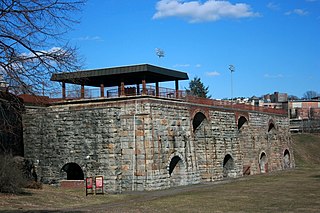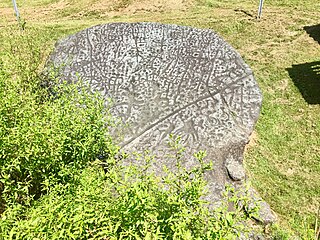Related Research Articles

Cullowhee is a census-designated place (CDP) in Jackson County, North Carolina, United States. It is located on the Tuckasegee River, and the permanent population was 6,228 as of the 2010 census.

Gaffney is a town in and the seat of Cherokee County, South Carolina, United States, in the Upstate region of South Carolina. Gaffney is known as the "Peach Capital of South Carolina". The population was 12,539 at the 2010 census, with an estimated population of 12,609 in 2019. It is the principal city of the Gaffney, South Carolina, Micropolitan Statistical Area, which includes all of Cherokee County and which is further included in the greater Greenville-Spartanburg-Anderson, South Carolina Combined Statistical Area.
John Donelson (1718–1785) was an American frontiersman, ironmaster, politician, city planner, and explorer. After founding and operating what became Washington Iron Furnace in Franklin County, Virginia for several years, he moved with his family to Middle Tennessee. It was on the developing frontier.

Nikwasi comes from the Cherokee word for "star", Noquisi (No-kwee-shee), and is the site of the Cherokee town which is first found in colonial records in the early 18th century, but is much older. The town covered about 100 acres on the floodplain of the Little Tennessee River. Franklin, North Carolina, was later developed by European Americans around this site.
The Endor Iron Furnace was an iron furnace that operated from 1861–1864 and again from 1870–1871, near Cumnock, Lee County, North Carolina. It was constructed between 1862 and 1864 to take advantage of the iron deposits along the Deep River. The furnace is constructed of soft local reddish-gray stones and measures approximately 32 feet square at the base and rises to a height of about 35 feet. During the American Civil War, the furnace produced pig iron for the Confederate Army.
The Battle of Taliwa was fought in Ball Ground, Georgia in 1755. The battle was part of a larger campaign of the Cherokee against the Muscogee Creek people, where an army of 500 Cherokee warriors led by Oconostota defeated the Muscogee Creek people and pushed them south from their northern Georgia homelands, allowing the Cherokee to begin settling in the region.

Cornwall Furnace is located near Cedar Bluff, Alabama in Cherokee County. It was built by the Noble Brothers to supply iron products to the Confederate States of America during the American Civil War.

The Scranton Iron Furnaces is a historic site that preserves the heritage of iron making in the U.S. State of Pennsylvania and is located in Scranton, near the Steamtown National Historic Site. It protects the remains of four stone blast furnaces which were built between 1848 and 1857. Iron production on the site was started by Scranton, Grant & Company in 1840. Later, the furnaces were operated by the Lackawanna Iron & Coal Company. In 1847, iron rails for the Erie Railroad were made at the site. In 1865, Scranton, Grant & Company had the largest iron production capacity in the United States. In 1875, steel production started at the site. In 1880, the furnaces produced 125,000 tons of pig iron, one of the main uses of which was in the making of t-rails. The plant was closed in 1902, when production was shifted to Lackawanna, New York.

Cowpens Furnace Site (38CK73) is the remains of an early 19th-century iron-making furnace in Cherokee County, South Carolina. The site shows early American iron-making technology. The site was listed on the National Register of Historic Places in 1987.
This is a list of the National Register of Historic Places listings in Stewart County, Tennessee.

Judaculla Rock is a curvilinear-shaped outcrop of soapstone known for its ancient carvings and petroglyphs. The archaeological site is located on a 0.85-acre rectangular-shaped property, now owned by Jackson County. It is approximately 60 meters east of Caney Fork Creek, a major branch of the northwestward-trending Tuckasegee River in the mountains of Western North Carolina.

The Beckley Furnace Industrial Monument is a state-owned historic site preserving a 19th-century iron-making blast furnace on the north bank of the Blackberry River in the town of North Canaan, Connecticut. The site became a 12-acre (4.9 ha) state park in 1946; it was added to the National Register of Historic Places in 1978.

Washington Iron Furnace is an historic iron furnace, located in Rocky Mount, Franklin County, Virginia. The granite furnace was built around 1770, and measures 30 feet high on its south face. It helped establish industry in the county, and was listed on the National Register of Historic Places in 1973.
Coopersville Ironworks Site (38CK2) and Susan Furnace Site (38CK67), also known as the Cherokee Ford Ironworks Site and Nesbitt Iron Manufacturing Co., is a historic archaeological site located near Gaffney, Cherokee County, South Carolina. The site includes the foundations of four large factory buildings, with a system of canal/sluiceways between them, and the remains of three iron furnaces. The outlying furnace, Susan Furnace, includes foundations, sluiceways, slag heaps, and adjacent ore pits. The complex is the largest and best preserved factory complex of any of the 19th century iron manufacturing companies of the region. The complex was developed between 1835 and 1843 by the Nesbitt Iron Manufacturing Company, the largest iron company in South Carolina. The Nesbitt Company was dissolved in the late 1840s, and the Swedish Iron Manufacturing Company of South Carolina operated the ironworks from 1850 until the American Civil War.
Ellen Furnace Site (38CK68) is a historic archaeological site located near Gaffney, Cherokee County, South Carolina. The site includes a partially collapsed but well-preserved iron furnace constructed about 1838 of quarried stone and two earthen sluiceways. Also present are building foundations, tramway road beds, and ore mines. It is directly associated with the nearby Susan Furnace Site. Both were outlying furnace operations associated with the manufacturing complex at Coopersville owned by the Nesbitt Company and later the Swedish Ironworks. The Coopersville Ironworks along with the Susan and Ellen Furnaces were developed between 1835 and 1843 by the Nesbitt Iron Manufacturing Company, the largest iron company in South Carolina. The Nesbitt Company was dissolved in the late 1840s, and the Swedish Iron Manufacturing Company of South Carolina operated the ironworks from 1850 until the American Civil War.
King's Creek Furnace Site (38CK71) is a historic archaeological site located near Kings Creek, Cherokee County, South Carolina, United States. The site contains a partially collapsed but well-preserved iron furnace built about 1838, retaining walls, sluiceway, stone dam abutments, stone building foundations, large piles of slag, and a large slag levee along the creek bank. It also includes the remains of the site's log frame dam. King's Creek Furnace Site is one of two remaining sites that can be associated with the King's Mountain Iron Company, a major iron manufacturing company that operated in present-day Cherokee County from about 1815 to about 1860. The other site is Jackson's Furnace Site in York County.
Thicketty Mountain Ore Pits (38CK74) is a historic archaeological site located near Shady Grove Church, Cherokee County, South Carolina. The site includes iron ore pits associated with the South Carolina Manufacturing Company, a major iron manufacturing company that operated in Spartanburg County between about 1825 and about 1850. The iron ore pits or surface mines cover several forested acres along a gently sloping ridge and are generally depressions about two to three meters deep and about five to ten meters across. The pits were last operational in the 1850s.

Eli Henderson Park at Janney Furnace is a park surrounding a fifty-foot tall stone furnace in Ohatchee, Alabama. The furnace was built in 1863 by Alfred Janney to produce pig iron due to the prevalence of iron ore in what is now the park. A July 1864 Union raid destroyed all but the stone chimney, which still remains. The furnace is now surrounded by the Calhoun County Confederate Memorial, built by Sons of Confederate Veterans in June 2003; and the 2009 Confederate and Native American Museum, which includes Civil War and Native American artifacts dating back to the Iron Age. The Confederate Memorial is the world's largest black granite confederate memorial. The furnace was listed on the National Register of Historic Places in 1976 and the surrounding park was re-named in honor of Eli Henderson in 2020, who sought to preserve it.
Saluda Old Town Site is a historic archaeological site located near Saluda, Saluda County, South Carolina. Archaeological remains indicate the site was occupied between 5,000 and 2,000 years ago. It was the site of a town of the Saluda people of the late-17th and early-18th century. On July 2, 1755, it was the site of a treaty signing recognizing the sovereignty of the King of England over all 360,000 square miles of Cherokee lands in South Carolina. In 1769, those lands formed the Ninety-Six District.

The Forest Dale Iron Furnace was a 19th-century iron smelting facility in Brandon, Vermont. Located off Vermont Route 73 east of the village of Forest Dale, it operated between 1810 and 1855, closing due to competition from higher quality and more efficient furnaces. Now reduced to archaeological ruins and the remains of its main furnace stack, it was listed on the National Register of Historic Places in 1974. The site is marked by a historic marker on Vermont 73.
References
- 1 2 "National Register Information System". National Register of Historic Places . National Park Service. July 9, 2010.
- ↑ unknown (n.d.). "Jackson's Furnace Site" (pdf). National Register of Historic Places - Nomination and Inventory. Retrieved 2014-07-01.
- ↑ "Nation Ford Road, York County (Ft. Mill vicinity)". National Register Properties in South Carolina. South Carolina Department of Archives and History. Retrieved 2014-07-01.

